SDB:DVD installation for 11.4
Tested on openSUSE
- in installing of 11.4
- with small differences also all versions
Recommended articles
Related articles

|
BootPlace your openSUSE DVD in the drive, and reboot your computer. Upon rebooting, you should see the boot screen. Select installation with arrow up/down and press enter. If your bios does not support boot from DVD, you might want to make your DVD bootable from within Windows using instlux.
Installation |

|
Step 1: Welcome screenOn top of the page you can set your language and keyboard layout. When the language is set, YaST will choose the applicable keyboard layout for you. However, if this is not correct, you can rectify this with the keyboard layout pull-down menu. Under the settings the end user license agreement (eula) is shown. To see the license agreement in other languages, click License Translation. If you accept the license, click Next.
|
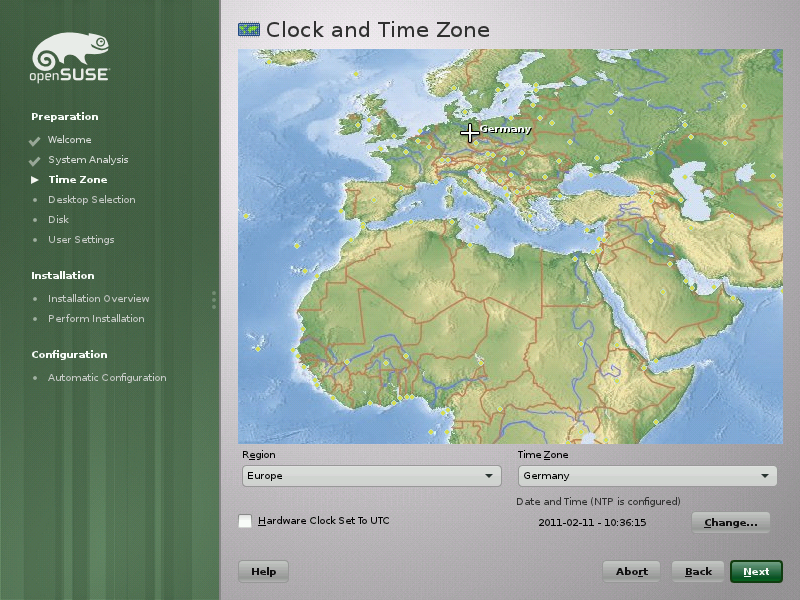
|
Step 2: Set the timeHere, you'll need to set your time zone which is displayed in the map of the world. You can select your time-zone by clicking on your country in the map or select it using the drop down menu's. You can choose to set your system time to UTC if you are not running a dual boot with windows. Windows does not use UTC time.
|
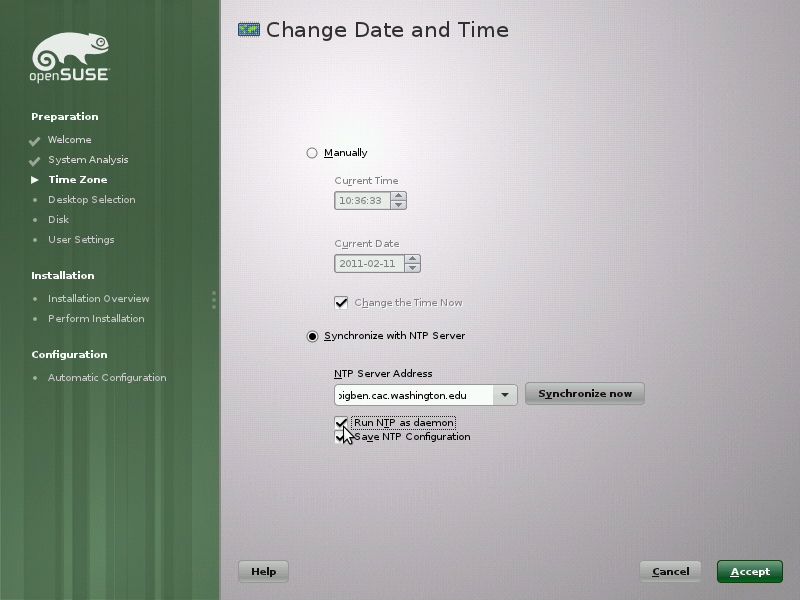
|
Below the time zones the current set time is displayed. If this is not correct click Change. Now you can change the time manually. If you have a working internet connection you can choose to select Synchronize with NTP server, to use a time server. You can choose a time server from the pull-down menu. Time will automatic be synchronized when clicking Accept.
|
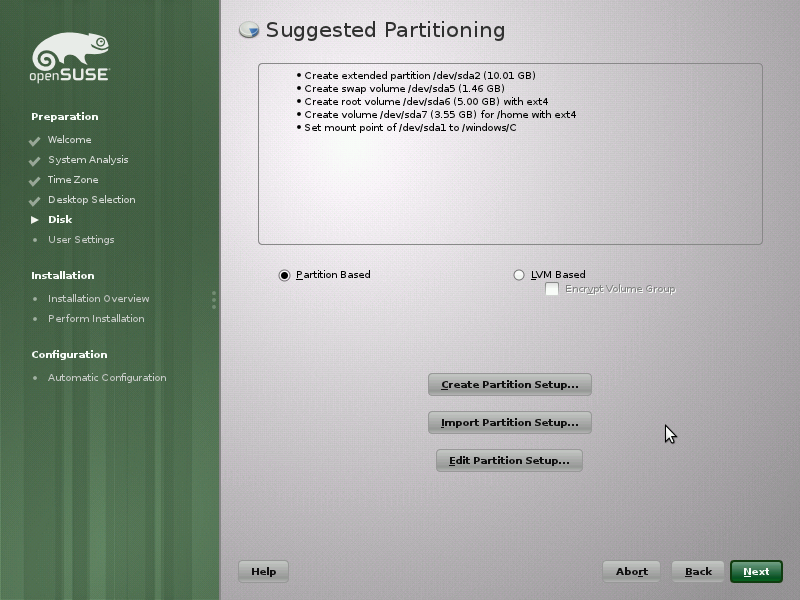
|
Step 3: Setting up your diskA suggested partition scheme for you hard disk is shown. If you have another operating system installed on the same hard disk (for example, Microsoft Windows or another Linux), YaST will resize that operating system so that it still on your computer, but has enough room to install openSUSE 11.4. If you are not happy about the proposed configuration, you can click Create partition setup. If you use Edit partiton setup the partitioning program is loaded, showing you the proposed configuration, which you can edit manually.
|
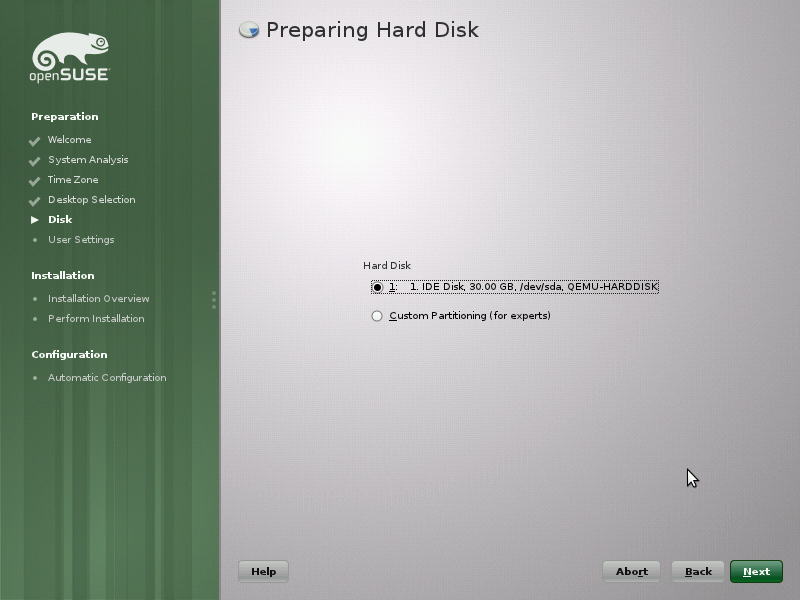
|
If you have clicked Create partition setup you will see this screen. Here you can select for which hard disk a partition setup should be proposed. If you choose Custom partitioning the partitioning program is loaded, showing you the current configuration of your disk, which you can edit manually. If you want to learn more on custom partitioning, please read SDB:Partitioning.
|
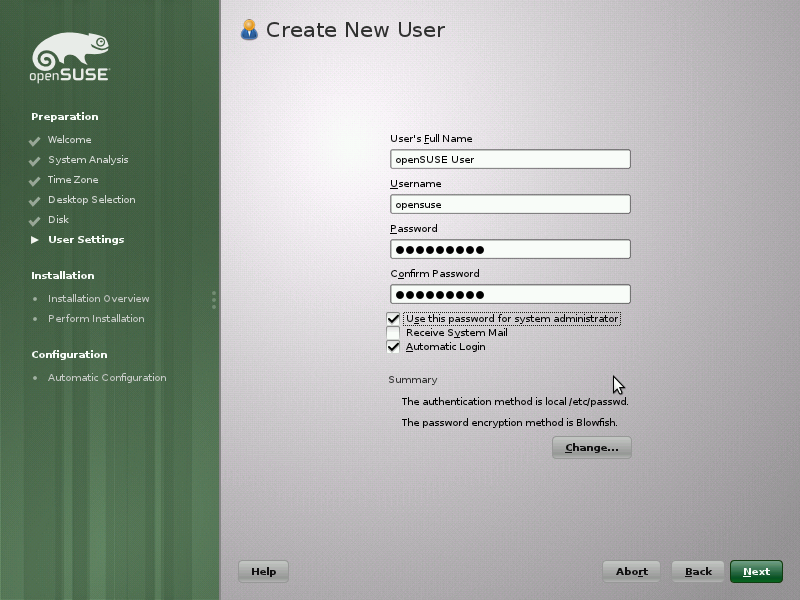
|
Step 4: Create the primary userEnter your full name, an user name will be automatically chosen. If you wish you can change this user name to your liking. Specify a new password twice, for verification. By default, the system is set to use this password for the system administrator (also known as root). Also, automatic login is turned on by default. However, if you wish to have a more secure system and/or multiple users, uncheck this options.
|
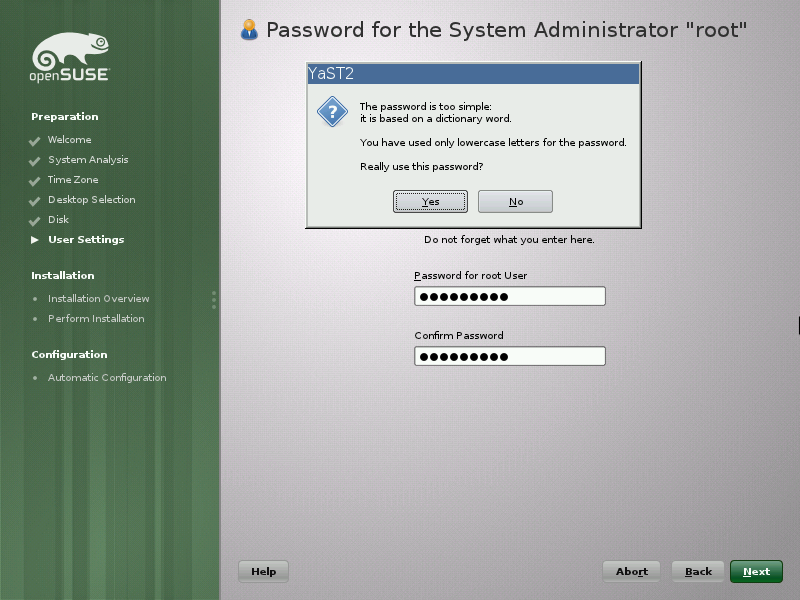
|
Set root password (optional)If you unchecked the Use this password for system administrator option in the previous screen, you have to provide a password for the user Root here. In this example a simple password was used, for which YaST warns you.
|

|
Step 5: Installation overviewThis is a summary of what YaST is planning on doing to your system. Read over the list and if you would like to change an option, click the title of the section. You can consult the help text in YaST for explanation of each item. BootingOpenSUSE uses GRUB to boot your system. A boot loader, like GRUB, is loaded by your system's bios, after which it loads the Linux kernel, sends specific options to the kernel and loads an initial ram-disk. This is necessary, since a bios is never capable to do this directly. GRUB also provides a chain loading option, to load another boot loader, like Windows. If you have a very large disk and your first (windows) partition is larger then 125GB, your bios most probably will not find the boot loader when booting. In this case you can click Enable on the Boot from MBR is disabled. This puts your boot loader at the beginning of your disk.
|
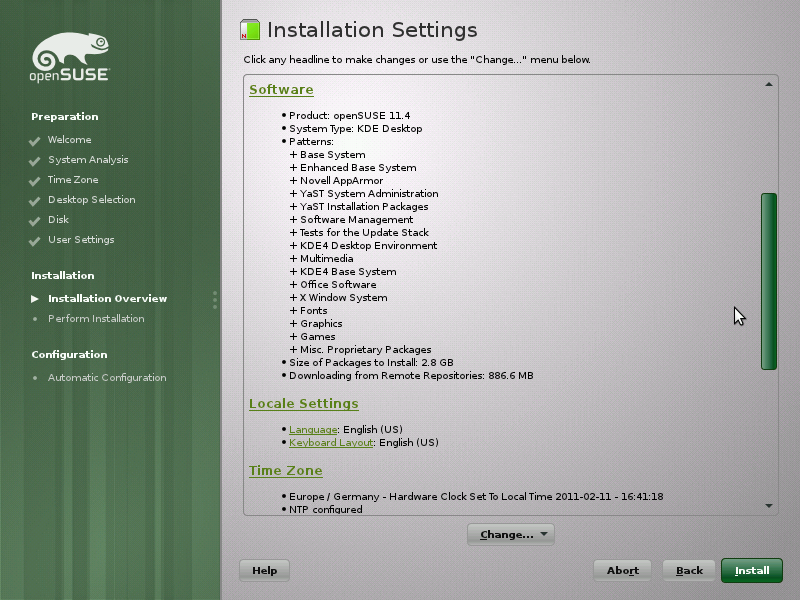
|
SoftwareThis is an overview of all the software that is going to be installed. If you want to install extra software, you can click the the section title. You can of course choose to install additional software after your system has been installed. Either way, please read YaST Software Management. Locale settingsYou can choose to change your language and keyboard layout settings here. If you change your language here, additional language packs will be installed and your desktop environment will be in the language as well.
|

|
Firewall and SSHA firewall is used to prevent unauthorized access from the network (and internet) to your computer. It is strongly recommended to keep this option enabled. SSH can be used to securely log in to your computer. This is typically a terminal login and does not include a desktop login. Unless you really know what you are doing, keep this option disabled. You can set various ways to remotely access your computer after the installation. Start installationIf you agree with this overview, click install. You will be prompted to confirm if you really want to proceed. Click Install again to confirm.
|
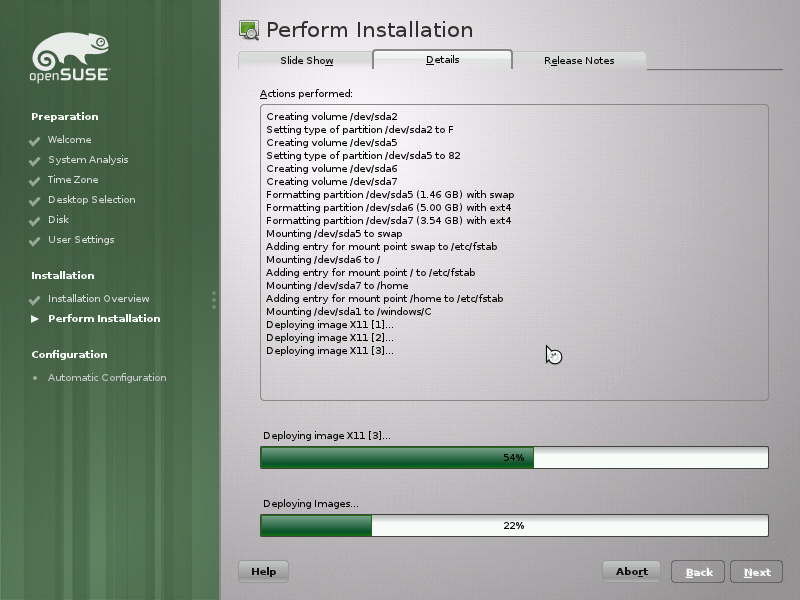
|
Step 6: InstallationYaST is now installing your new openSUSE system. Initially you will be shown a slideshow about some nice features of openSUSE 11.4. If you click Details you will see the steps performed in the installation. Under the tab Release notes you can read the release notes. Once finished, you'll be directed to restart the computer. Restart the computer, and remove the openSUSE install disc.
|

|
Step 7: Finishing the InstallationOn the first boot YaST will automatically configure your system's hardware and network settings.
|
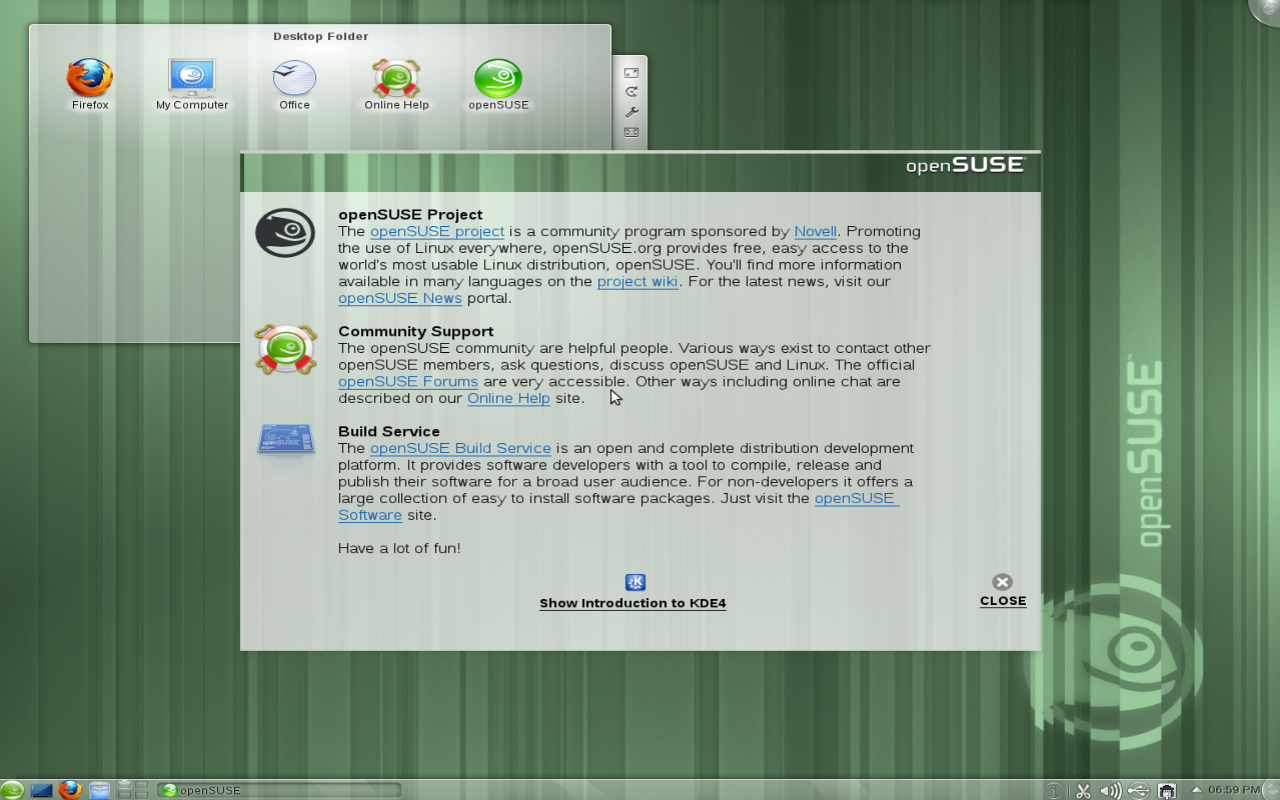
|
Completion of InstallationopenSUSE 11.4 is now installed! Once you login, you'll be greeted by the openSUSE Greeter with all sorts of information about openSUSE on it. Updates should have been configured automatically, and probably the first update messages will appear, if you are connected to the internet. You might want to check configuration to get yourself started!
|
Note on installation to large partitions
Many users will be upgrading from previous dual boot windows-linux distributions. YaST will detect empty ext3 partitions, say on a second hard disk and offer to convert them to ext4. For example if there are two empty ext3 partitions it will create an root ext4 partition and data ext4 partition, with the larger partition being assigned to data (/home) by default. On modern systems the scary warning in the Boot section just before commitment during installation, that GRUB will place the bootloader above 125 GBytes and the user is risking that the bootloader will not be found can be disregarded (of course with a certain risk). A check is possible before commitment if you cancel the install at this stage before you lose a useful MBR. Without a valid MBR a disk will not be accessible anymore and steps must be taken to recover all the data on that disk You can do this in an old linux distro that uses GRUB by copying your old linux root partition to the partition that you will use, and adding a new entry to GRUB menu.lst with as root partition this test root partition. If a boot test goes well you can then delete the contents of the temporary test root partition and the SUSE installer may well use it as its default root ext4 partition.
What next?
There is plenty of documentation available on this wiki.